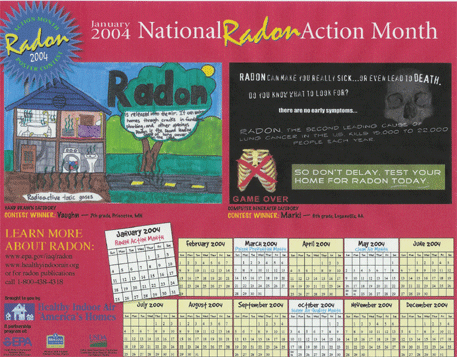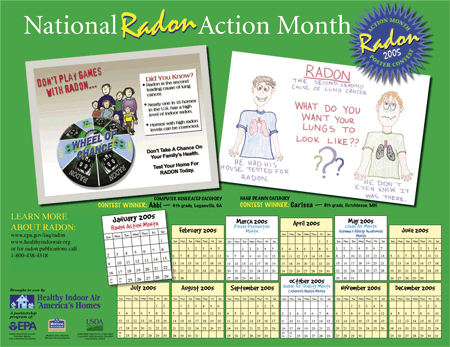August 2005 // Volume 43 // Number 4 // Tools of the Trade // 4TOT7
Using a Poster Contest to Educate Children About Radon
Abstract
This article presents a strategy to
involve children in radon education through a poster contest. This educational
effort completed its third year, sponsored by the Healthy Indoor Air for
America's Homes program in collaboration with government partners. The contest
is directed at middle school children with goals that include fostering coalitions
between local radon partners and state radon programs, creating local publicity
and awareness about radon, increasing radon testing, and publicizing Radon
Action Month. Student posters are judged on accuracy, visual communication
of topic, and reproducibility. The two national winners are recognized in
Washington, DC.
Introduction
For a third year Healthy Indoor Air for America's Homes, the U.S. Environmental Protection Agency (EPA), and the U.S. Department of Agriculture-Cooperative State Research, Education and Extension Service (USDA-CSREES) jointly sponsored a middle school (grades 4-8) radon poster contest in 2004. This annual contest is intended to increase radon awareness and testing through a variety of community and media events. It can be implemented at a state or designated local level.
Healthy Indoor Air for America's Homes <www.healthyindoorair.org> encourages 4-H clubs to participate in future Radon Action Month poster contests and community awareness campaigns, because radon is the second leading cause of lung cancer. It is estimated that nearly one in 15 U.S. homes has a high indoor radon level, and the U.S. Surgeon General and EPA recommend all homes be tested for radon.
The theme of the poster contest is radon awareness and radon risk reduction, as well as the hazards associated with radon. Posters are judged on content accuracy, visual communication of topic, and reproducibility. It is important for 4-H clubs interested in participating in the contest to contact their State Radon Office (contacts at www.epa.gov/iaq/contacts.html) about this activity because these offices have information and resources useful for developing the contest. It also helps to discuss the level of involvement these offices are able to offer.
A radon awareness PowerPoint presentation is available by contacting the national coordinator of the contest, Barbara Allen, with Montana State University Extension Service <blallen@montana.edu>. The State Radon Program office can offer state-specific information. Other partners can include a local county Extension office, schools, American Lung Association office, affiliates of the National Safety Council, and members of the American Association of Radon Scientists and Technologists (AARST) <www.aarst.org>.
The radon poster contest goals are to:
- Foster coalitions between local radon partners and state radon programs.
- Increase local publicity and awareness about radon.
- Increase radon testing.
- Generate interest, enthusiasm, and action about radon testing, radon mitigation, and radon resistant new construction at the grassroots level.
- Publicize Radon Action Week/Month and the toll free hotline (1-800-SOS-RADON) to empower people to take action.
- Increase government, state, and local officials' awareness of the importance of radon risk reduction.
Poster Contest Ideas
Implementation
State poster contest leads are designated for each participating state. A 4-H leader can be the state lead or might decide to participate in other ways. Cooperation with a classroom having a teacher acting as the lead is a possibility. Each state lead is asked to carry out the following duties:
- Promote the poster contest to area middle school-aged children through club leaders or teachers.
- Collect the winning posters or have them sent by participating clubs or schools.
- Select the county winners.
- Coordinate poster contest awards ceremonies and awareness programs at the clubs, schools, or county fairs.
- With a group, select winning posters for the state and coordinate a state award ceremony with media coverage.
- Submit the state winner to Montana State University Extension Service for national judging.
To help fund the poster contest, USDA-CSREES offers mini-grants. For more information about these mini-grants contact Barbara Allen.
Guidelines
Entries may be submitted in either the hand-drawn or the computer-generated poster category. With assistance from the state radon directors and/or state Extension partners, 4-H club leaders and teachers are asked to aid students in the development of artwork. A radon presentation by an Extension educator, State Radon Program representative, or AARST member can provide students the knowledge they need for developing the poster.
In order to qualify for the contest, it is required that one of the following radon topics be depicted in the artwork:
- What is radon?
- Where is radon found?
- Where does radon come from?
- Health effects of radon.
- Radon test being performed.
- Radon mitigation taking place.
- House structure undergoing radon resistant new construction.
Artwork must be original and the work of one student only. Students need to focus on one of the seven topics and give their poster a title. This title and topic category should be listed on the artwork submission form, which is available on-line. Specifications for the posters are as follows. Size: 12" x 18" horizontal format only, with 1" borders. Materials: white drawing paper; crayon, marker, paint (watercolor, tempera, or acrylic), collage, photograph, or computer graphic. Lettering and messages must be large enough to reproduce well. The student's name must not appear on the front of the artwork.
Ceremonies
Award ceremonies and prizes can include awarding certificates (a template of the award certificate can be downloaded) and distributing free radon test kits and coupons (or information) to all in attendance to test their home for radon. Materials can be displayed and distributed at the ceremony. They are available from the State Radon Program office or from the Healthy Indoor Air for America's Homes Web site. After the ceremony, sponsors are encouraged to submit an article to a local newspaper about radon and the ceremony. Winning posters can be displayed at various community locations as part of Radon Action Month (January).
Conclusion
In 2004 there were 28 posters submitted from 14 states for the national competition, judged at Montana State University. The 2004 winning posters were unveiled at an awards ceremony in Washington, DC, in January 2005 and nationally distributed. (Calendars produced using 2003 and 2004 winning posters are shown in Figure 1). The two national poster contest winners and their chaperones (sponsoring teacher, Cooperative Extension educator, or State Radon Program manager) each won an all-expense paid trip to participate in the ceremony.
Figure 1.
Calendars Using Winning Radon Posters from the 2003 and 2004 Contests
to Highlight Radon Awareness


An important goal is to expand involvement in the poster contest. Leaders of 4-H clubs and other Extension educators are encouraged to become involved. The timeline for the 2005 competition will be announced mid-summer. Visit the Healthy Indoor Air for America's Homes Web site for the radon poster contest timeline, materials, and additional information
